Open green space, unique boutiques ad handsome architecture – this area of west London has changed dramatically from a past synonymous with intrigue and scandal.
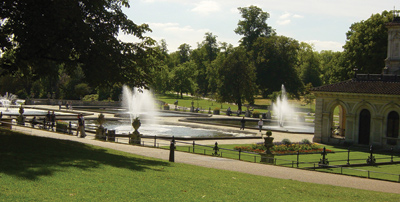 |
| The Italian Gardens in Kensington Gardens, Bayswater |
With its elegant stuccoed terraces, chic apartment blocks and leafy squares, it’s hard to imagine that Bayswater, until relatively recently, was considered by inhabitants of Knightsbridge and Kensington to be “the wrong side” of Hyde Park. Its first inhabitant was medieval Abbot Bainiardus (or Baynard), who administered lands belonging to the Abbey of Westminster. But the name is probably a mixed corruption of Baynard and Bear’s Watering: springs used for growing watercress.
Londoners were initially loath to settle the area because of its proximity to Tyburn Gallows, which stood where Marble Arch is now, at the junction of Bayswater Road and Oxford Street. A plaque marks the spot. For over 500 years this was the capital’s main execution site, where 200,000 people would come to watch ‘Jack Ketch’ the executioner dispatch young and old, some hanged for stealing a morsel of bread.
Paradoxically, when property developers built those smart houses round charming squares between 1830-60, aiming to emulate the success of Belgravia on the south side of the Park, they called the area ‘Tyburnia’. Another reason, perhaps, for fashionable buyers’ lack of enthusiasm.
Just along Bayswater Road is Tyburn Convent for French Benedictine nuns. In the basement, they show visitors a shrine with a mock-up of the gibbet and relics of martyrs. Next door, now owned by the convent, is London’s smallest house, measuring three and a half feet across.
Today, Bayswater property is as sought-after – and as expensive – as its snooty cross-Park neighbours’. But only 40-odd years ago and despite illustrious past inhabitants like J M Barrie, A J Cronin, Baden-Powell and Winston Churchill, it had a fairly louche reputation. Ladies of the night lined Bayswater Road and society osteopath Stephen Ward introduced naïve MP John Profumo to Christine Keeler, mistress of a Soviet naval attaché, in his Orme Court flat, provoking a national scandal. Boarding houses along Sussex Gardens weren’t always what they seemed.
But all that seediness is swept away and it’s a pleasure to stop and stroll in Bayswater at any hour. I stayed in the glamorous London Lancaster Hotel whose 18 floors and 416 luxuriously appointed rooms give fantastic views over London. “You can sightsee without leaving your room,” joked Jo, my guide. An ideal centre for exploring the area, it’s a footstep from Kensington Gardens, as I saw from my lunch table in the cool Island Restaurant.
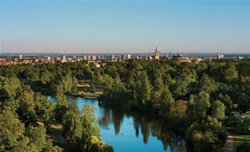 |
| Views from the Lancaster London Hotel |
The Gardens were first opened to the public in George IIs reign. “Formal dress only and no soldiers, sailors or servants”. Later, Queen Victoria allowed everyone in and a Russian aristocrat announced that they were”…a middle-class rendezvous” and that “good society” only went there “to drown itself”! They could also go there to swim in the Serpentine – partly the West Bourne river and partly natural springs – as the hardy still do, especially on Christmas Day, even in snow.
Another favourite local pursuit is horse riding in fashionable Rotten Row – or Route du Roi. With stables near London Lancaster Hotel, it’s a pleasant way to pass an hour among greenery. But after taking Peter Pan Afternoon Tea, appropriately with fairy cakes and ‘Lost Boy Sandwiches’, and been given breadcrumbs to feed the ducks, I headed for the beautiful Italian Gardens with their fountains and flowers.
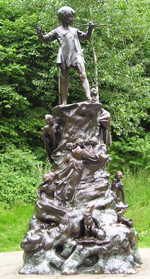 |
| Peter Pan statue |
From there it’s a stroll across the grass to Peter Pan’s waterside statue. Commissioned by author J M Barrie, it was erected in secret in 1912. Small children were being photographed next to tiny animals carved in the base.
Barrie, who lived at 100 Bayswater Road, met the five Llewellyn-Davies, his ‘Lost Boys’ in the Gardens. The tragic boys sailed their boats on nearby Round Pond – as I did as a child (mine sank). George I, who lived in nearby Kensington Palace in the 18th century, kept his edible turtles in the pond.
A short walk east brings you to Diana, Princess of Wales’ swirling waterfall and play pool. She lived in a Kensington Palace apartment and, while the 17th-century building undergoes a refurbishment (reopening 2012), visitors can see a special changing exhibition, Enchanted Palace. This transforms the State Apartments with a magical look at their history, fashion and famous inhabitants.
Just across the road is Queensway, Bayswater’s ‘high street’, full of ethnic restaurants. I went to Whiteleys, launched in the late 19th century by the eponymous ‘Universal Provider’ – “we supply everything from a pin to an elephant”. William Whiteley was murdered in 1907. The present building was opened after a fire in 1911, and legend has it that Hitler planned to make Whiteley’s his London HQ!
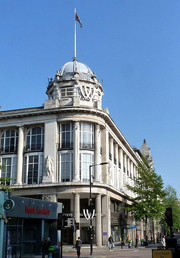 |
| Whiteleys, Queensway |
Whiteleys is now an airy shopping mall on three floors, with restaurants and a cinema, and clever development has left the beautiful ironwork staircase, marble floors and soaring pillars. Whittard’s china teapots shaped like London buses and chintz tea cosies, Dunes irresistible shoes and Jigsaw’s fabulous frocks caught my eye. Upstairs on a pillar, I found a 1920s advertisement for “Unshrinkable Directoire Knickers in wool”. Cedar, rose and putty colour: 3s.11d. Outsize: 5s.” Itchy.
There’s a large Greek community here and in Moscow Road stands Edwardian St Sophia’s Orthodox Cathedral with gold and marble interior. Some Saturdays visitors can attend a service with Byzantine music. Close by in Westbourne Grove is Khan’s, famous for Indian food since the 1960s, and several Persian and Lebanese restaurants.
Head westwards for Pembridge Villas with chic dress and gift shops and Tavola, an excellent European deli which also sells pretty teatowels and pottery. Cinephilia west is a café, bookshop, gallery and cinema showing avant garde films, “The only one in London” assured the proprietor. I liked the retro posters.
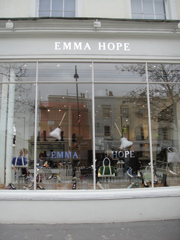 |
| Emma Hope for fabulous shoes |
On the left is Ledbury Road with Emma Hope’s fabulous shoes and charming Marie-Chantal children’s boutique, where I was tempted by a knitted snail on wheels! Designer Paul Smith and Smythson (where celebs buy their stationery) are a step away.
This area heaves with around two million fun-lovers during Notting Hill Carnival, the world’s biggest outside Rio. Each August Bank Holiday Sunday and Monday, West Indian, Latin American and Asian communities parade in flamboyant costumes and floats. There’s dancing in the streets, spicy food and live performances from 10am onwards.
Portobello Road, seedy in the 1960s, is now very posh, especially following the 1999 film Notting Hill. Property prices have soared and would-be Williams (Hugh Grant) or Annas (Julia Roberts) abound!
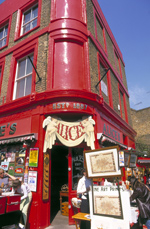 |
| Portobello Road |
The top end contains antique emporia, where there is almost everything from a pin to an elephant. This is for serious collectors who will explore all the nooks and crannies to search out a bargain. Two Japanese haggled over a silver teapot, while an Italian family were snapped with a smiling policeman. Make for the market beyond the vegetable stalls for old records, vintage clothes, jewellery, shoes and handbags and where I picked up a 1930s bangle for a song.
Pop into Portobello Green, an arcade of little shops selling slightly classier things like Sasti’s handmade children’s clothes, Poppy Valentine’s bags and vintage fabrics and What Katy Did vintage lingerie: copies of 1950s undies, swimwear and stockings. I fancied the Betty Grable robe, but settled for an Italian icecream at Roly’s Café.
Off the vegetable market is Blenheim Crescent with two splendid shops: The Travel Bookshop and Books for Cooks. Celebrity chefs browse here and you can sample the dish of the day. A walk along Westbourne Park Road westwards from the Market brought me to designer Celia Birtwell’s unique fabrics, wallpaper and gift shop and Tom Conran’s (son of Terence) delightful Victorian gastropub, The Cow.
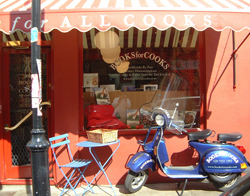 |
| Books for Cooks |
Rosemead Gardens, off Elgin Crescent, is where William and Anna climbed over the fence in Notting Hill. It’s still private, so I spent a peaceful hour in Kensal Green Cemetery instead! One of London’s seven 19th-century burial grounds, full of fallen angels and mausolea, it’s not too far from Portobello Road. Thackery, Trollope, Mary Seacole and Leigh Hunt are buried here. I discovered Charles Blondin – Jean-Francois Gravelet – who crossed Niagara on a tightrope but ended life in unadventurous Ealing.
Walk to Kilburn Lane nearby for its eccentric Victorian gastropub, Paradise On the Way to Kensal Green. Named after G K Chesterton’s poem, The Rolling English Road, its décor is a fun mix of furniture, books and flowers, with “Amazing Roasts” on Sundays. Next door is Rise, great for gifts.
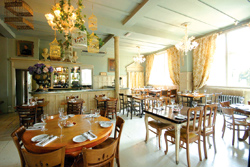 |
| Dining room at The Paradise |
Back in Notting Hill Gate, past The Coronet and The Gate cinemas, stands Geale’s famous fish restaurant. Tucked away in Farmer Street, one of several pretty little backstreets, it’s an ideal place for alfresco summer eating, because you won’t be gassed by passing traffic! The fish pie is fabulous, too.
To round off the day, stroll down Holland Park Avenue to Campden Hill, where the local celebs favourite pub Windsor Castle makes a delightful watering hole on warm days. But if you’re looking for somewhere to put your feet up, I recommend Holland Park itself. This oasis has everything: sit and smell the flowers among peacocks and plashing fountains. An ideal spot to round off your exploration of the “wrong side of the Park”.
Further information
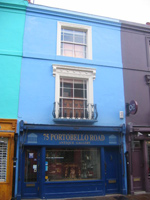 |
- Visiting London:
for further information on where to stay and what to do in London, go to www.visitlondon.com. - Kensington Gardens and Hyde Park: www.royalparks.org.uk.
- Whiteleys: famous department store now a ‘mall’. www.whiteleys.com.
- Lancaster London (4-star): hotel just across the road from Hyde Park and Kensington Gardens, fabulous views from higher floors.
- Portobello Market: one of London’s most famous markets, along most of Portobello Road. www.portobellomarket.org.
- The Travel Bookshop: Popular travel specialist bookshop, opened in 1979. 13-15 Blenheim Crescent, Notting Hill; tel: (020) 7229 5260; www.thetravelbookshop.com.
- Books for Cooks: bookshop with cookery demonstrations upstairs. 4 Blenheim Crescent, Notting Hill. ; tel: (020) 7221 1994; www.booksforcooks.com.
- Geales: fish restaurant in Notting Hill. Click here for our review.
- Paradise by Way of Kensal Green: characterful west London gastropub. 19 Kilburn Lane, Kensal Green; tel: (020) 8969 0098; http://theparadise.co.uk.
- Electric Brasserie: by the famous Electric Cinema on Portobello Road. Tel: (020) 7908 9696. www.electricbrasserie.com.
- The Notting Hill Carnival: each August Bank Holiday weekend (Sunday 29 and Monday 30 August 2010). www.thenottinghillcarnival.com.

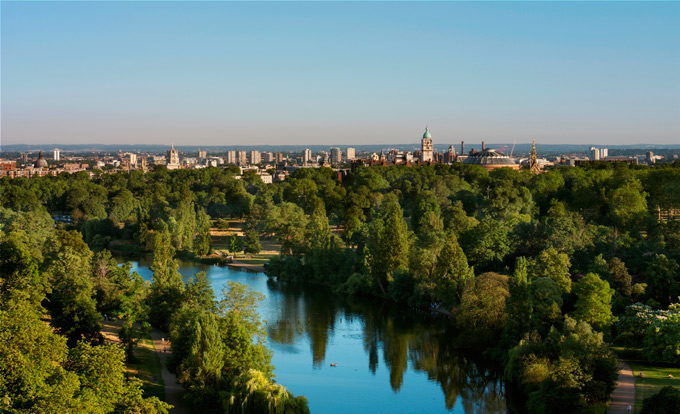




 © 2024
© 2024